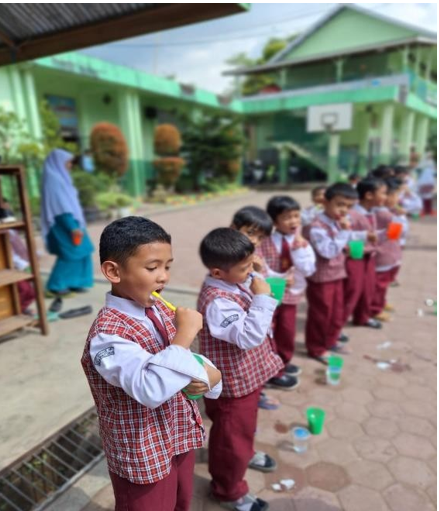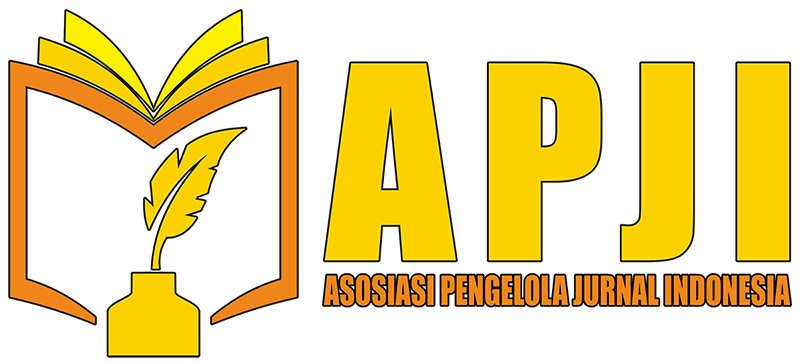Menuju Indonesia Bebas Karies Tahun 2030 Melalui Upaya Promotif dan Preventif Kesehatan Gigi Anak Usia Sekolah Dasar di SDIT Cahaya Hati Bukittinggi
Abstract
Dental caries is a dental health problem that has a major impact on individuals and society in terms of pain and suffering, functional impairment and reduced quality of life. The aim of this activity is to increase children's knowledge and self-care behavior in the field of dental health, improve dental and oral hygiene, and prevent dental caries in children in order to move towards a Caries-Free Indonesia 2030. The implementation method includes promotional efforts, namely counseling and demonstrations, efforts Prevention includes plaque control, joint toothbrushing and early detection of dental caries. The results of the activities increased the knowledge of SDIT Cahaya Hati students about dental health through dental health education activities. Increased tooth brushing behavior and dental and oral hygiene status of students through joint tooth brushing activities. The prevalence of caries among students at Cahaya Hati Elementary School, Bukittinggi City is 80.2% with an average DMFT of 4.1, meaning that each child has 4 teeth with caries experience which is dominated by the Decayed (D) component, namely 2.7, meaning that each student needs 2 teeth filling treatment. 3 teeth. 79.3% of students have tooth surfaces free from tartar. Conclusion: Increased knowledge of SDIT Cahaya Hati students about dental health and the impact of smoking on dental health.
Downloads
References
Kemenkes. Rencana Strategis Kementerian Kesehatan Tahun 2020-2024. Kemenkes. 2020;21(1):1-9.
Kemenkes. Peraturan Meteri Kesehatan RI Tentang Upaya Kesehatan Gigi dan Mulut. Permenkes. 2016;(151).
Kemenkes. Pedoman Usaha Kesehatan Gigi Sekolah. Kemenkes; 2012.
WHO. Global Strategi On Oral Health. WHO. 2021;(August):1-9.
WHO. Oral health. Exec Board. 2020;(December).
Kemenkes RI. Pengembangan dan Riset Kesehatan Dasar (Riskesdas) 2013. Published online 2013:163-182.
Kemenkes. Laporan Riskesdas Nasional 2018. Kemenkes. Published online 2018:120.
Nova Herawati. Validitas Reprodusibilitas Perawat Gigi Dalam Menilai Kebutuhan Perawatan Karies Gigi Menggunakan Indeks CAST.; 2015.
Edwina A.M Kidd SJ and B. Dasar-Dasar Karies (Terj). EGC; 2002.
Megananda Hiranya Putri, Eliza Herjulianti NN. Ilmu Pencegahan Penyakit Gigi Dan Mulut. (Juwono drg L, ed.). EGC; 2018
Deinzer R, Cordes O, Weber J, et al. Toothbrushing behavior in children - An observational study of toothbrushing performance in 12 year olds. BMC Oral Health. 2019;19(1):1-9.
Santi AUP, Khamimah S. Pengaruh Cara Menggosok Gigi terhadap Karies Gigi Anak Kelas IV di SDN Satria Jaya 03 Bekasi. JurnalUmjAcId. 2019;(1):hal 48-51. https://jurnal.umj.ac.id/index.php/SEMNASFIP/article/view/5109
Luthviatin N A. Determinan perilaku hidup bersih dan sehat pada siswa sekolah dasar. FKM Univ, Jember. Published online 2011:73-74.
Amalia dkk. The Role of school-based dental programme on dental caries experience in Yogyakarta. Int Paediatry Dent. Published online 2012:203-210.

Copyright Notice
Pernyataan Hak Cipta dan Lisensi
Dengan mengirimkan manuskrip ke Jurnal Pengabdian Masyarakat Cendikia Jenius, penulis setuju dengan kebijakan ini. Tidak diperlukan persetujuan dokumen khusus.
Hak Cipta :
Lisensi Creative Commons Atribusi-NonKomersial-BerbagiSerupa 4.0 Internasional
Hak cipta atas artikel apa pun di Jurnal Pengabdian Masyarakat Cendikia Jenius dipegang penuh oleh penulisnya di bawah lisensi Creative Commons CC BY-NC-SA 4.0.
- Hak cipta pada setiap artikel adalah milik penulis.
- Penulis mempertahankan semua hak mereka atas karya yang diterbitkan, tak terbatas pada hak-hak yang diatur dalam laman ini.
- Penulis mengakui bahwa Jurnal Pengabdian Masyarakat Cendikia Jenius sebagai yang pertama kali mempublikasikan dengan lisensi Creative Commons Atribusi 4.0 Internasional (CC BY-NC-SA-4.0).
- Penulis dapat memasukan tulisan secara terpisah, mengatur distribusi non-ekskulif dari naskah yang telah terbit di jurnal ini kedalam versi yang lain (misal: dikirim ke respository institusi penulis, publikasi kedalam buku, dll), dengan mengakui bahwa naskah telah terbit pertama kali pada Jurnal Pengabdian Masyarakat Cendikia Jenius.
- Penulis menjamin bahwa artikel asli, ditulis oleh penulis yang disebutkan, belum pernah dipublikasikan sebelumnya, tidak mengandung pernyataan yang melanggar hukum, tidak melanggar hak orang lain, tunduk pada hak cipta yang secara eksklusif dipegang oleh penulis.
- Jika artikel dipersiapkan bersama oleh lebih dari satu penulis, setiap penulis yang mengirimkan naskah menjamin bahwa dia telah diberi wewenang oleh semua penulis bersama untuk menyetujui hak cipta dan pemberitahuan lisensi (perjanjian) atas nama mereka, dan setuju untuk memberi tahu rekan penulis persyaratan kebijakan ini. Jurnal Pengbadian Masyarakat Cendikia Jenius tidak akan dimintai pertanggungjawaban atas apa pun yang mungkin timbul karena perselisihan internal penulis.
Lisensi :
Jurnal Pengabdian Masyarakat Cendikia Jenius diterbitkan berdasarkan ketentuan Lisensi Creative Commons Atribusi-NonKomersial-BerbagiSerupa 4.0 Internasional (CC BY-NC-SA 4.0). Lisensi ini mengizinkan setiap orang untuk :
Menyalin dan menyebarluaskan kembali materi ini dalam bentuk atau format apapun serta menggubah, memperbaiki, dan membuat ciptaan turunan, bahkan untuk kepentingan komersial, selama mereka mencantumkan kredit kepada Penulis atas ciptaan asli.
























